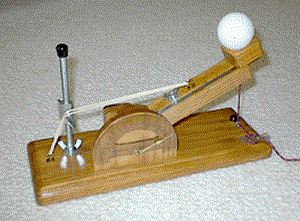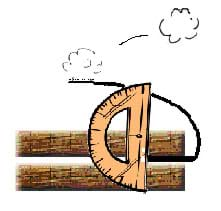Quick Look
Grade Level: 8 (7-9)
Time Required: 45 minutes
Expendable Cost/Group: US $5.00
Group Size: 4
Activity Dependency: None
Associated Informal Learning Activity: Design a Catapult
Subject Areas: Algebra, Physical Science, Physics
NGSS Performance Expectations:

| MS-PS2-2 |
Summary
Students observe the relationship between the angle of a catapult (a force measurement) and the flight of a cotton ball. They learn how Newton's second law of motion works by seeing directly that F = ma. When they pull the metal "arm" back further, thus applying a greater force to the cotton ball, it causes the cotton ball to travel faster and farther. Students also learn that objects of greater mass require more force to result in the same distance traveled by a lighter object.
Engineering Connection
Understanding the scientific concepts of Newton's laws of motion has made it possible for engineers to build airplanes that fly, elevators and amusement park rides that are exciting but safe, cars that drive safely at high speeds and structures that do not collapse. Aerospace engineers save fuel by exploiting the second law when they let the planet's force of gravity pull a spacecraft towards the planet to increase its velocity, and then steer the spacecraft away from crashing into the planet.
Learning Objectives
After this activity, students should be able to:
- Recognize that understanding the scientific concepts described by Newton's laws of motion enables engineers to design airplanes, amusement park rides, elevators, and much more.
- Use the catapult model to explore the force exerted on the cotton ball and graph the correlation between angle (force) and distance traveled (acceleration).
- Collect data throughout this experiment, including the maximum height of the cotton ball in flight and the distance traveled until it lands on the floor.
- Calculate the average of a data set.
Educational Standards
Each TeachEngineering lesson or activity is correlated to one or more K-12 science,
technology, engineering or math (STEM) educational standards.
All 100,000+ K-12 STEM standards covered in TeachEngineering are collected, maintained and packaged by the Achievement Standards Network (ASN),
a project of D2L (www.achievementstandards.org).
In the ASN, standards are hierarchically structured: first by source; e.g., by state; within source by type; e.g., science or mathematics;
within type by subtype, then by grade, etc.
Each TeachEngineering lesson or activity is correlated to one or more K-12 science, technology, engineering or math (STEM) educational standards.
All 100,000+ K-12 STEM standards covered in TeachEngineering are collected, maintained and packaged by the Achievement Standards Network (ASN), a project of D2L (www.achievementstandards.org).
In the ASN, standards are hierarchically structured: first by source; e.g., by state; within source by type; e.g., science or mathematics; within type by subtype, then by grade, etc.
NGSS: Next Generation Science Standards - Science
| NGSS Performance Expectation | ||
|---|---|---|
|
MS-PS2-2. Plan an investigation to provide evidence that the change in an object's motion depends on the sum of the forces on the object and the mass of the object. (Grades 6 - 8) Do you agree with this alignment? |
||
| Click to view other curriculum aligned to this Performance Expectation | ||
| This activity focuses on the following Three Dimensional Learning aspects of NGSS: | ||
| Science & Engineering Practices | Disciplinary Core Ideas | Crosscutting Concepts |
| Plan an investigation individually and collaboratively, and in the design: identify independent and dependent variables and controls, what tools are needed to do the gathering, how measurements will be recorded, and how many data are needed to support a claim. Alignment agreement: Science knowledge is based upon logical and conceptual connections between evidence and explanations.Alignment agreement: | The motion of an object is determined by the sum of the forces acting on it; if the total force on the object is not zero, its motion will change. The greater the mass of the object, the greater the force needed to achieve the same change in motion. For any given object, a larger force causes a larger change in motion. Alignment agreement: All positions of objects and the directions of forces and motions must be described in an arbitrarily chosen reference frame and arbitrarily chosen units of size. In order to share information with other people, these choices must also be shared.Alignment agreement: | Models can be used to represent systems and their interactions. Alignment agreement: |
Common Core State Standards - Math
-
Construct and interpret scatter plots for bivariate measurement data to investigate patterns of association between two quantities. Describe patterns such as clustering, outliers, positive or negative association, linear association, and nonlinear association.
(Grade
8)
More Details
Do you agree with this alignment?
International Technology and Engineering Educators Association - Technology
-
Explain how knowledge gained from other content areas affects the development of technological products and systems.
(Grades
6 -
8)
More Details
Do you agree with this alignment?
State Standards
Colorado - Math
-
Construct and interpret scatter plots for bivariate measurement data to investigate patterns of association between two quantities.
(Grade
8)
More Details
Do you agree with this alignment?
Colorado - Science
-
Predict and evaluate the movement of an object by examining the forces applied to it
(Grade
8)
More Details
Do you agree with this alignment?
Materials List
Each group needs:
- 2 wooden blocks
- 1 thin strip of metal banding (8-inches long)
- 1 protractor
- 4 long nails (or a C-clamp, or duct tape)
- 1 small nail
- 1 cotton ball
- 1 hammer
- tape measure or meter stick
- Newton's Second Law – Catapult Worksheet, one per student
Worksheets and Attachments
Visit [www.teachengineering.org/activities/view/cub_mechanics_lesson04_activity1] to print or download.Introduction/Motivation
Catapults were first used around 400 BC in Greece and China as weapons to launch rocks, arrows and other projectiles against enemies. In the centuries after their first appearance, bigger and bigger catapults were constructed. Over time, catapults were made so big that they became too difficult to use, and eventually were no longer used. However, the fundamental concepts used in working catapults are still in use every day.
Engineers need to understand how much force is required to make an object with a certain mass move. Catapults are one good way to learn about the relationship between force, mass and acceleration. The relationship F = ma is called Newton's second law of motion because it is a mathematical description of the relationship among force, mass and acceleration.
Procedure
Before the Activity

- Gather materials and make copies of the Newton's Second Law – Catapult Worksheet.
- Choose appropriate locations for students to fire their catapults.
With the Students
- Open with a discussion question: Has anyone ever seen or built a catapult? How does it work? Tell the students that we will find out more about this in today's activity.
- Hand out a worksheet to each student.
- Bend the metal banding into an L shape and insert the "L" end between the two wooden blocks (see Figure 1).
- Hold the blocks securely in place by one of three options: Nail them together by hammering two nails on either side of the metal stripping, use a C-clamp or use duct tape to hold the blocks together.
- Tape the protractor vertically to the front of the catapult, close to the metal band (arm).
- Ask students make predictions (hypotheses) of what angle of the catapult they expect will make the cotton ball travel highest and furthest.
- Once the catapult is built, assign roles to each team member. Instruct one student to fire the cotton ball, one to spot the maximum height of the cotton ball when in flight, one to spot the landing point where the cotton ball first hits the ground, and two to measure the height and distance of flight.
- Place cotton ball at the end of the arm.
- Pull the metal band (arm) back 10° and release. If it flies straight up or backwards, fire again. Conduct two trials.
- Have students record their measurements on the worksheet as they proceed through the activity.
- Repeat firing process at 20° through 90°.
- Have students complete the rest of the worksheet.
- While waiting for other students to finish their worksheets, have students with completed worksheets compare their answers with their peers.
- Review worksheet answers as a class.
Assessment
Pre-Activity Assessment
Discussion Questions: Solicit, integrate and summarize student responses.
- Has anyone ever seen or built a catapult? How does it work?
Activity Embedded Assessment
Worksheet: Have students record measurements and follow along with the activity on the Newton's Second Law – Catapult Worksheet. After students have finished their worksheets, have them compare answers with their peers.
Post-Activity Assessment
Worksheet Discussion: As a class, review and discuss the worksheet answers. Student answers reveal their depth of understanding and mastery of the subject.
Safety Issues
While cotton balls are of minimal concern, have students wear safety glasses if they use other objects as projectiles.
Troubleshooting Tips
The cotton ball may fly straight up or even backwards from the catapult. If this occurs, have the student repeat the process for that angle again.
Students need to pay close attention to observe exactly where the maximum height occurs. Tell them to be sure to keep their "eye on the ball."
Make sure students record the distance traveled with respect to where the ball lands, not where it rolls to a stop.
Activity Extensions
Repeat the experiment with different objects to examine the affect of mass on the force and acceleration due to the catapult.
Internet research: What is the biggest catapult ever made? When were catapults used as weapons? How are catapults still used today? (Hint: Search for catapults and aircraft carriers.)
Activity Scaling
- For lower grades, work together to complete the worksheet; do the averages together as a class. Substitute a bar graph for the X-Y plot.
- For upper grades, have each individual complete his/her own worksheet, computing averages and making the plots.
Subscribe
Get the inside scoop on all things TeachEngineering such as new site features, curriculum updates, video releases, and more by signing up for our newsletter!More Curriculum Like This

Students explore motion, rockets and rocket motion while assisting Spacewoman Tess, Spaceman Rohan and Maya in their explorations. First they learn some basic facts about vehicles, rockets and why we use them. Then, they discover that the motion of all objects—including the flight of a rocket and mo...

Students learn more about forces by examining the force of gravitational attraction. They observe how objects fall and measure the force of gravitational attraction upon objects.

Students learn what a pendulum is and how it works in the context of amusement park rides. While exploring the physics of pendulums, they are also introduced to Newton's first law of motion — about continuous motion and inertia.
References
Activity adapted from AIMS Education Foundation, 1987. http://www.aimsedu.org/
Copyright
© 2004 by Regents of the University of ColoradoContributors
Sabre Duren; Ben Heavner; Malinda Schaefer Zarske; Denise W. CarlsonSupporting Program
Integrated Teaching and Learning Program, College of Engineering and Applied Science, University of Colorado BoulderAcknowledgements
The contents of this digital library curriculum were developed under grants from the Fund for the Improvement of Postsecondary Education (FIPSE), U.S. Department of Education, and National Science Foundation (GK-12 grant no. 0338326). However, these contents do not necessarily represent the policies of the Department of Education or National Science Foundation, and you should not assume endorsement by the federal government.
Last modified: September 26, 2022








User Comments & Tips